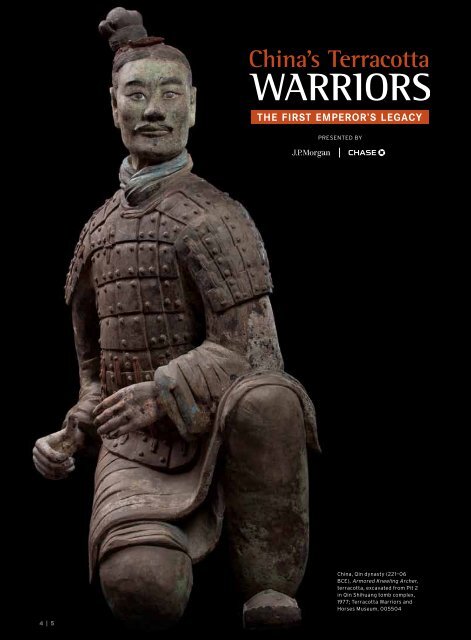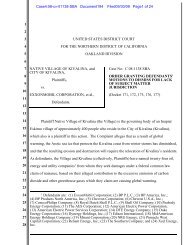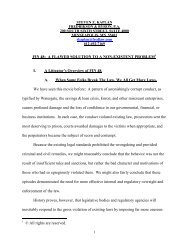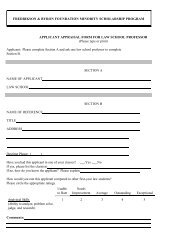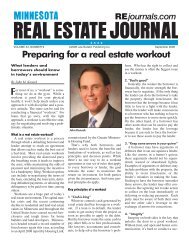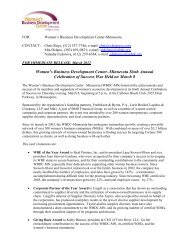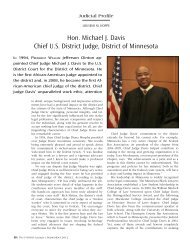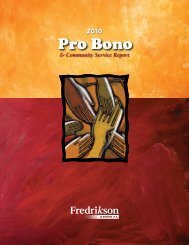Read More - Fredrikson & Byron PA
Read More - Fredrikson & Byron PA
Read More - Fredrikson & Byron PA
You also want an ePaper? Increase the reach of your titles
YUMPU automatically turns print PDFs into web optimized ePapers that Google loves.
4 | 5<br />
Presented by<br />
China, Qin dynasty (221–06<br />
bCe), Armored Kneeling Archer,<br />
terracotta, excavated from Pit 2<br />
in Qin shihuang tomb complex,<br />
1977; terracotta Warriors and<br />
Horses Museum, 005504
The First Emperor and His<br />
Ghost Army: An Epic Story<br />
by Liu yang, Phd, head of the MIA’s Asian Art department<br />
and curator of Chinese Art<br />
LIKE MOST of China’s amazing archaeological discoveries,<br />
the astounding “Ghost Army” was found by accident.<br />
In 1974, local farmers were drilling a well in a location<br />
almost one mile from the First Emperor’s tomb mound.<br />
They were astonished to discover fragments of terracotta<br />
figures. Shortly thereafter, Chinese archaeologists excavated<br />
three pits containing more than 7,000 terracotta warriors<br />
of different ranks, together with horses and chariots, all<br />
designed to protect an extraordinary man in his afterlife.<br />
The man, Qin Shihuang, was a ruler who has been<br />
described as both a cruel and brutal sovereign, and a hero<br />
and revolutionary. Born in the Warring States period<br />
(475–221 BCE), a time of turmoil in China’s history, Qin<br />
Shihuang is renowned as the founder of a united China and<br />
the short-lived Qin dynasty (221–206 BCE). He forged the<br />
seven warring states into one nation and rose from stately<br />
king to Qin Shihuang, the First Emperor. He left a legacy<br />
of a centralized and bureaucratic China, which would be<br />
carried onto successive dynasties over the next two millennia.<br />
Driven by his eagerness for immortality, the First<br />
Emperor began to plan his burial from the moment he<br />
ascended the throne at the tender age of 13. Building the<br />
tomb took almost 38 years. Bordered by a protective outer<br />
wall extending over a mile from north to south and nearly a<br />
mile from east to west, the complex mausoleum, as gradually<br />
revealed by the ongoing archaeological excavations, is far<br />
beyond anyone’s imagination.<br />
One by one remarkable discoveries have emerged,<br />
including two meticulously cast bronze chariots, dozens<br />
Above: China, Qin dynasty (221–06 bCe), Chariot Horse (detail), terracotta,<br />
excavated from Pit 1, in Qin shihuang tomb complex, 1978; terracotta<br />
Warriors and Horses Museum, 002545<br />
below: China, Qin dynasty (221–06 bCe), Crane, bronze, excavated from<br />
Pit K0007 in Qin shihuang tomb complex, 2002; terracotta Warriors and<br />
Horses Museum, 005970<br />
of life-sized bronze water birds, thousands of stone armors<br />
and helmets, and more than 10 terracotta acrobats and civil<br />
officials. It is clear the First Emperor planned his tomb as an<br />
elaborate subterranean palace, a parallel world comprising<br />
stables, offices, an armory, and an imperial zoo, which<br />
would enable his rule into the afterlife.<br />
Every day new finds reveal the wealth of China’s ancient<br />
past. This is an epic story that is far from fully told. The<br />
exhibition, “China’s Terracotta Warriors: The First Emperor’s<br />
Legacy,” opening October 28 in Target Galleries, presents the<br />
renowned “Ghost Army,” including a kneeling archer with<br />
well-preserved pigments on his armor and face. It also displays<br />
significant recent finds from the First Emperor’s mausoleum<br />
and from other sites around the Qin capital, Xianyang, thus<br />
telling the evolving story of China. Marvelous key objects<br />
include a group of four bronze water birds—a crane, a swan,<br />
and two geese—all life size. These are masterworks of bronze<br />
casting that, like the pottery warriors, herald a new era in<br />
the material arts of China. A bronze bell with inlaid gold and<br />
silver designs was unearthed from a location near the First
Emperor’s tomb mound. The works from the latest excavation<br />
(2005) possibly reveal the tomb of the First Emperor’s<br />
grandmother. Weapons and other objects relating to the Qin<br />
dynasty’s government provide the most tangible evidence we<br />
have of the First Emperor’s achievements and vision in unifying<br />
a country and its politics.<br />
The content of the exhibition is not limited to the<br />
findings from Qin Shihuang’s tomb complex. It further<br />
explores the period of Chinese history preceding the Qin<br />
dynasty. When Qin Shihuang came to the throne, the Qin<br />
state, surrounded by six strong states that annexed others<br />
to consolidate their power, had been in existence for over a<br />
half-century. The rulers of this kingdom played their parts<br />
in developing a small kingdom into a superpower. In the<br />
absence of substantive and reliable written sources, it is<br />
archaeological evidence that provides us with clues about the<br />
history and evolution of the state of Qin.<br />
While the ritual and burial practices of the Qin<br />
state retain distinctive characteristics, they also reveal a<br />
fundamental adherence to the spiritual tradition of the<br />
previous Western Zhou (11th century–771 BCE) dynasty.<br />
This is demonstrated by the Qin’s use of ritual bronzes. Like<br />
the aristocrats of the early dynasties, Qin rulers used the<br />
bronzes in ceremonies and sacrifices performed to please<br />
“China’s TerraCoTTa Warriors:<br />
The FirsT emperor’s LegaCy ”<br />
Presented by<br />
October 28, 2012, through January 20, 2013<br />
Target Galleries<br />
Ticketed exhibition (free for MIA members)<br />
This exhibition was organized by the Minneapolis Institute of Arts<br />
in partnership with the Asian Art Museum and the Shaanxi Provincial<br />
Cultural Relics Bureau and Shaanxi Cultural Heritage Promotion<br />
Centre, People’s Republic of China.<br />
Lead Sponsors:<br />
Additional support provided by Christie’s and the E. Rhodes and<br />
Leona B. Carpenter Foundation.<br />
Media Partner: Official Airline:<br />
6 | 7<br />
ancestors and heavenly deities and<br />
to maintain the order from the<br />
heavens. Bronze ritual vessels and<br />
paraphernalia, even those used in<br />
earthly ritual and ceremony, were<br />
also placed in the tombs and burial<br />
sites of deceased rulers and nobility.<br />
These furnishings were intended to<br />
support and sustain the deceased in<br />
the afterlife.<br />
While the production of bronze<br />
vessels shows Qin’s adherence<br />
to mainstream Shang and Zhou<br />
traditions, the achievements of its goldsmiths distinguish its<br />
art. Gold and silver were sparingly used for objects of special<br />
and often personal value, such as ornaments, fittings, belt<br />
buckles, and ritual accoutrements. Gold was also used for<br />
luxuries such as horse-and-chariot decorations. These castgold<br />
objects include animal masks and serpentine patterns<br />
similar to those on the bronzes and jades. One excellent<br />
example in the exhibition is an iron sword with an openwork<br />
gold hilt ornamented with inlaid turquoise (above).<br />
Archaeological revelations indicate a steady eastward<br />
movement of the Qin people from their original homeland in<br />
the western frontier of Gansu, relocating the capital several<br />
times. A group of architectural materials in the exhibition<br />
gives a hint of the palaces and buildings that once graced the<br />
Qin capital cities.<br />
The exhibition features more than 120 rare objects<br />
drawn from 13 museums in China, presenting a panoramic<br />
view of the Qin dynasty. <br />
Above: China, spring and Autumn period (770–476 bCe), sword blade<br />
with Inlaid Openwork Hilt, iron and gold with inlaid turquoise, excavated<br />
from tomb 2 at yimen Village in baoji, shaanxi, in 1992; baoji Municipal<br />
Archaeological Institute byM2:15<br />
below: China, spring and Autumn period, duke Wu’s reign (697–678 bCe),<br />
bo bell, bronze, excavated at taigongmiao village, yangjiagou in baoji,<br />
shaanxi, 1978; baoji bronze Museum, shaanxi, 02755/IA5.4
Liu Yang, PhD, is the MIA’s curator of Chinese Art and head of the Asian Art<br />
Department. He studied in China and Great Britain, and was most recently<br />
senior curator of Chinese Art at the Art Gallery of New South Wales, Sydney.<br />
Working for so long on this project, both in Australia and in the States, Liu<br />
said, “I feel I had almost become the commander of the Terracotta Army<br />
myself!” When the exhibition closes, he would like to stand in front of the<br />
alignment and give an authoritative order: “Dismissed!”<br />
China, Qin dynasty<br />
(221–06 bCe), View<br />
of Pit 1 showing the<br />
terracotta army<br />
lined up at attention<br />
facing east
news | opportunities<br />
The MIA Thanks Sponsors of<br />
“China’s Terracotta Warriors”<br />
BRINGING ICONIC WORKS of art from China to the Twin Cities is no easy feat.<br />
Consider the time and care needed to transport 8 ancient terracotta warriors, gold<br />
and silver ornaments, ceremonial vessels, and other rare artifacts. These are coming<br />
to the Minneapolis Institute of Arts this fall as part of “China’s Terracotta Warriors:<br />
The First Emperor’s Legacy,” opening October 28 in Target Gallery.<br />
Through the help of several generous corporate partners,<br />
the MIA is able to present this spectacular exhibition to our<br />
community—giving visitors the chance to experience more<br />
than 120 archaeological discoveries, some of which have<br />
rarely been seen outside of China.<br />
The MIA thanks JPMorgan Chase, <strong>Fredrikson</strong> &<br />
<strong>Byron</strong> P.A., and Delta Air Lines for sponsoring this special<br />
exhibition and for helping the museum provide insight into<br />
one of history’s most remarkable cultures and time periods.<br />
Conducting business throughout the world, these companies<br />
understand the importance of both enhancing cultural<br />
understanding within local communities and encouraging<br />
diverse worldviews through art.<br />
“It’s important to help our community learn first-hand<br />
about cultures around the world and their histories,” said<br />
24 | 25<br />
Michele Martin, managing director for JPMorgan Chase,<br />
the presenting sponsor for “China’s Terracotta Warriors.”<br />
“We’re thrilled to partner with the MIA on this once-ina-lifetime<br />
exhibition, which tells an amazing story that<br />
continues to develop to this day.”<br />
<strong>Fredrikson</strong> & <strong>Byron</strong> President John Koneck also sees<br />
great significance surrounding this exhibition. “We’re<br />
fortunate that the MIA, a world-class institution, can bring<br />
renowned works of art from around the globe to Minnesota,”<br />
he said. “<strong>Fredrikson</strong> & <strong>Byron</strong> is proud to support such a<br />
remarkable show.”<br />
Along with the exhibition, visitors can take advantage<br />
of public tours, lectures, educational resources, and other<br />
programs developed to enhance their experience of “China’s<br />
Terracotta Warriors.” At the same time, they are able to<br />
take in the MIA’s world-renowned permanent<br />
collection of Chinese art.<br />
“This exhibition is sure to intrigue and<br />
inspire those who experience it,” said Bill<br />
Lentsch, senior vice president of Minnesota<br />
operations for Delta Air Lines. “Helping to<br />
make exhibitions like this possible is a vital<br />
part of supporting strong communities where<br />
our employees and customers live and work.”<br />
The MIA is grateful to these corporate<br />
partners, who make exhibitions like this<br />
possible. <br />
Above: China, Qin dynasty (221–06 BCE), Armored<br />
General (detail), terracotta, excavated from Pit 1, Qin<br />
Shihuang tomb complex, 1980, Terracotta Warriors and<br />
Horses Museum, 000847<br />
At left: From left, Bill Lentsch, senior vice president<br />
of Minnesota operations for Delta Air Lines; Liu Yang,<br />
the MIA’s Chinese art curator; John Koneck, president,<br />
<strong>Fredrikson</strong> & <strong>Byron</strong>; and Michele Martin, managing<br />
director for JPMorgan Chase.


